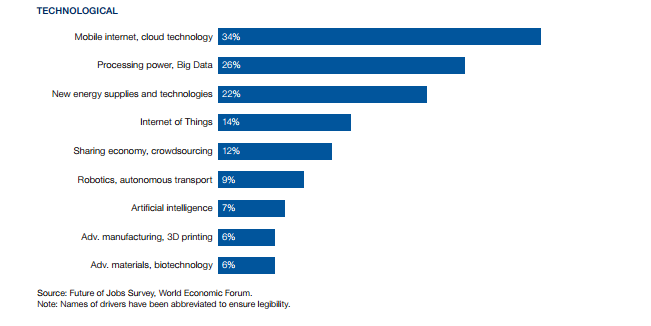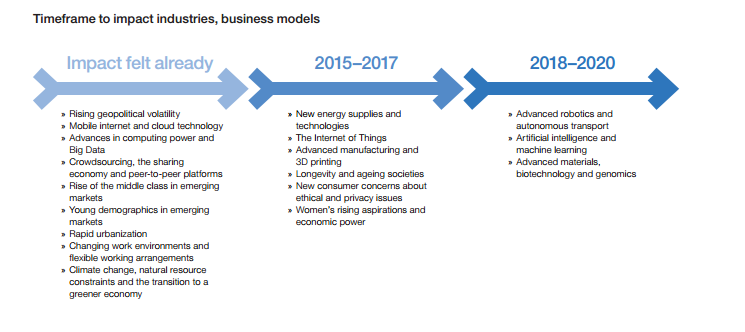World Economic Forum’s Future of Jobs report, developed in collaboration with the Global Agenda Council, uses the dataset of a survey of CHROs and other senior talent and strategy executives examining 371 leading global employers that represent over 13 million employees. It predicts that the rapidly evolving employment landscape will force businesses, governments and individuals to anticipate and prepare for future skill requirements, and studies the drivers of change, employment trends, and emerging skills in order to propose future workforce strategies and recommendations.

The study finds that the majority of respondents believe urgent adaptive action is required to address drivers that they predict will occur within the next five years. The changing nature and flexibility of work tops the list of demographic and socio-economic drivers of change, while mobile internet, cloud technology, processing power, and big data are considered fundamental technological change drivers. On average, those surveyed believe the impacts of mobile internet and cloud technology, Big Data, and crowdsourcing are already being felt, and consider IoT, 3D printing, and concerns about ethical and privacy issues to impact from 2015 to 2017. Advanced robotics, artificial intelligence, and advanced materials are deemed to be just around the corner, with respondents predicting impacts to industries and business models in these areas will be felt from 2018 to 2020.

Current trends across the surveyed countries may lead to 5.1 million jobs lost due to disruptive labor market changes between 2015 and 2020, as 7.1 million jobs generally concentrated in routine white collar office functions such as administrative and office roles are lost, and 2 million jobs are created in the architectural, engineering, computer, and mathematical fields. It’s likely new and emerging roles will become critically important, and both data analysts and specialized sales representatives were consistently pointed to across all industries and areas. Across in-demand job families, it’s likely that recruitment will become even more difficult than it already is, and organizations are going to have to find efficient ways of ensuring reliable talent sourcing.
The Future of Jobs report further notes reduced shelf-life of employees’ existing skill sets, and technological disruptions are likely to quickly enhance this challenge.
It’s estimated that by 2020 more than a third of required core skill sets of most occupations will consist of skills not considered crucial today, and strong social skills such as emotional intelligence and collaboration attitudes will have to supplement technical skills. Workers in lower skilled roles are likely to face redundancy without significant reskilling and upskilling.
With business leaders slow to act on these looming challenges to date, most of those surveyed prioritize future workforce planning reasonably or very highly. Approximately two-thirds of respondents intend to invest in reskilling current employees while some promising possibilities such as making better use of the experience of older employees and building an ageless workforce seem to be underutilized.
The report details four areas requiring immediate focus: Reinventing the HR Functions; Making Use of Data Analytics; Talent Diversity; and Leveraging Flexible Working Arrangements and Online Talent Platforms, as well as three areas for longer term focus: Rethinking Education Systems; Incentivizing Lifelong Learning; and Cross-Industry and Public-Private Collaborations. Government policies and reforms will need to complement these strategies, and organizations and individuals need to become involved in the management and direction of these disruptive changes that are likely to entirely reinvent our economies.
By Jennifer Klostermann





